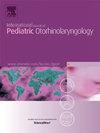儿童吸入异物:新西兰单一高等教育中心10年经验。
IF 1.2
4区 医学
Q3 OTORHINOLARYNGOLOGY
International journal of pediatric otorhinolaryngology
Pub Date : 2025-02-01
DOI:10.1016/j.ijporl.2025.112234
引用次数: 0
摘要
目的:儿童吸入性异物(FB)是一种潜在的危及生命的疾病,其诊断具有挑战性。我院此前发表于2014年的一项类似研究创建了一个指南,建议在疑似FB吸入时何时进行喉支气管镜检查(LB),敏感性超过99%。分级系统包括有无急性病史、阳性检查和/或放射学表现,包括亲眼所见的窒息、发音困难、喘鸣、呼吸减少或检查时的异常放射学表现。目前的研究进一步回顾了10年零5个月的数据,以重新评估三种阳性结果对怀疑吸入性FB的儿童的诊断有用性。方法:我们对2013年8月至2023年1月期间在我院因疑似急性FB误吸而行LB手术的所有患者进行回顾性分析。我们分析了患者的特征、临床检查、放射学表现和结果。结果:我们共发现100名16岁以下儿童因怀疑FB误吸而行LB。我们研究人群的平均年龄为2.6岁。人口统计数据与我们机构之前的研究结果相似,Māori和Pasifika儿童在LB上发现FB的可能性最高。以疑似FB吸入性表现的男性儿童在LB上发现异物的可能性是女性儿童的1.39倍(p = 0.04)。总的来说,有两个或两个以上阳性结果的敏感性为100%。病史或单独检查更敏感(均为95.6%),但特异性较低(分别为12.5%和31.3%)。单独的异常放射学特异性更高(75.0),但敏感性较低(77.9%)。最常见的部位是右支气管树(45.6%),其次是左支气管树(39.7%)。95%的FB是有机的,54%是坚果。支气管镜检查阴性率为32%。结论:在我们的儿科人群中,病史、检查和放射学结果中的两个或两个以上阳性指标仍然是吸入性异物存在的高度敏感的预测因素。我们建议将来进行大规模的多中心研究,以确认这些发现在更广泛的患者队列中是否适用。本文章由计算机程序翻译,如有差异,请以英文原文为准。
Aspirated foreign bodies in children: 10-Years experience in a single tertiary centre in New Zealand
Objective
Aspirated foreign bodies (FB) are potentially life-threatening conditions which can be challenging to diagnose in children. The previous similar study from our hospital, published in 2014, created a guideline suggesting when to proceed to laryngobronchoscopy (LB) in suspected FB aspiration with over 99 % sensitivity. The grading system included the presence or absence of acute history, positive examination, and/or radiological findings, including witnessed choking, dysphonia, stridor, wheezing, or reduced air entry on examination or abnormal radiological findings. The current study reviewed a further 10 years and 5 months of data to re-evaluate the ongoing diagnostic usefulness of the three positive findings in children with suspicion of aspirated FB.
Methods
We undertook a retrospective review of all LB performed at our institution for suspected acute FB aspiration from August 2013 to January 2023. We analysed patient characteristics, clinical examination, radiological findings, and outcomes.
Results
We found a total of 100 children under the age of 16 years who underwent LB for suspected FB aspiration. The mean age of our study population was 2.6 years. The population demographics were similar to the results from the previous study from our institution, with Māori and Pasifika children having the highest probability of finding a FB on LB. Male children presenting for suspected FB aspiration are 1.39 times more likely than female children to have a foreign body at LB (p = 0.04). Overall, having two or more positive findings had a sensitivity of 100 %. History or examination alone are more sensitive (both 95.6 %) but less specific (12.5 % and 31.3 %, respectively). Abnormal radiology alone was more specific (75.0) but less sensitive (77.9 %). The most common site of FB was the right bronchial tree (45.6 %), followed by the left (39.7 %). 95 % of FB were organic, and 54 % were nuts. The negative bronchoscopy rate was 32 %.
Conclusion
Two or more positive indicators in history, examination and radiological findings continue to be highly sensitive predictors for the presence of an aspirated foreign body in our paediatric population. We recommend a future large-scale multicentre study to confirm how applicable these findings would be to a broader cohort of patients.
求助全文
通过发布文献求助,成功后即可免费获取论文全文。
去求助
来源期刊
CiteScore
3.20
自引率
6.70%
发文量
276
审稿时长
62 days
期刊介绍:
The purpose of the International Journal of Pediatric Otorhinolaryngology is to concentrate and disseminate information concerning prevention, cure and care of otorhinolaryngological disorders in infants and children due to developmental, degenerative, infectious, neoplastic, traumatic, social, psychiatric and economic causes. The Journal provides a medium for clinical and basic contributions in all of the areas of pediatric otorhinolaryngology. This includes medical and surgical otology, bronchoesophagology, laryngology, rhinology, diseases of the head and neck, and disorders of communication, including voice, speech and language disorders.

 求助内容:
求助内容: 应助结果提醒方式:
应助结果提醒方式:


